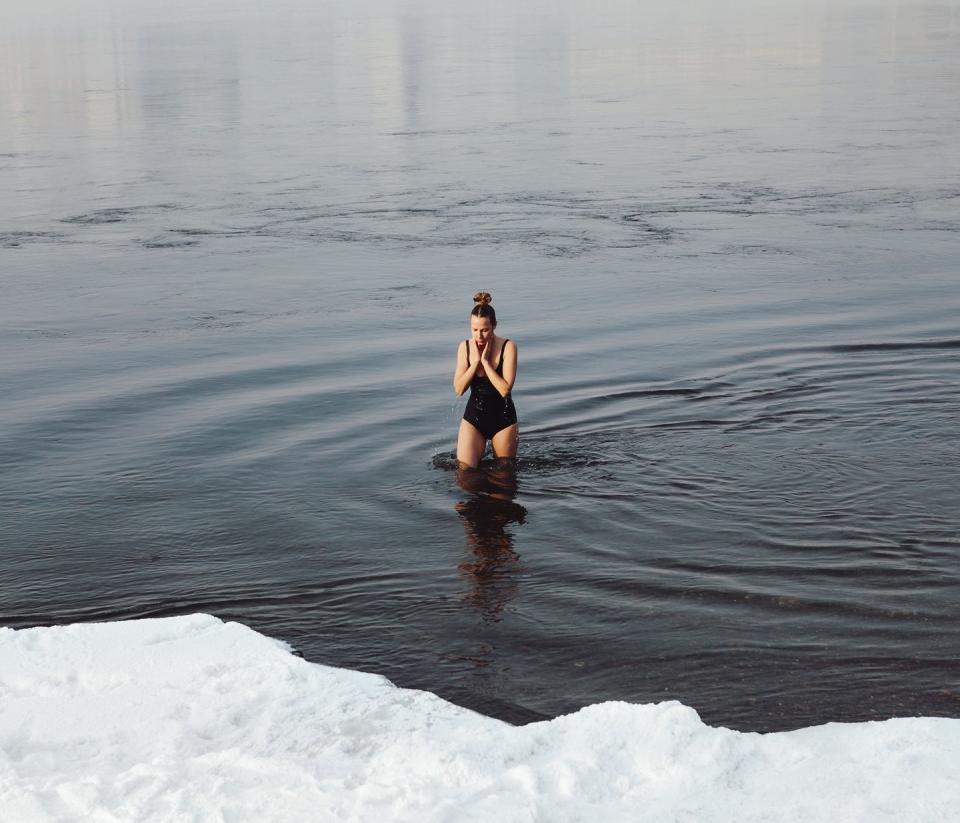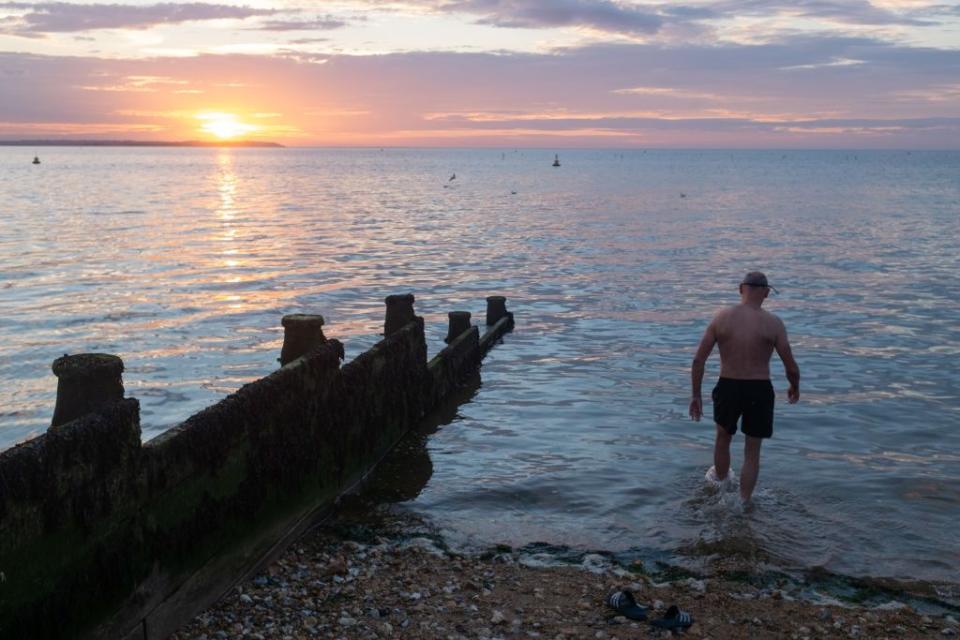A cold water swimmer on how she became addicted to the thrill after a New Year's Day dip

In the icy waters off Whitstable beach, Katherine May joins the New Year’s Day swimmers. Why? Because there’s comfort to be found in the cold, she says…
It’s New Year’s Day and a group of 25 us are standing on the tawny Whitstable shingle in Kent, muttering that the timing is brutal this year. At low tide, the sea stretches so far out that you have to wade through acres of mud to reach it – meaning if you want to swim, you’re at the mercy of the tide times. So here we are, at 9am, some of us in winter coats, some in dressing gowns. There is a surprising array of animal onesies. We are all watching the churning grey water and imagining how cold it is.
This is the annual Whitstable New Year swim – not an organised event like in other towns, but instead a casual affair, usually planned a couple of days in advance through Facebook messages and faintly hysterical texts. We all know the deal: run in, scream, run out again. Retire to someone’s house to eat bacon sandwiches, drink coffee and congratulate ourselves.

A fair crowd has assembled by now. Not everyone is swimming. Some people simply come to watch. There’s a distinct gender divide: most of the swimmers are women, and most of the observers are their baffled partners. At the top of the beach, someone is burning their Christmas tree in a fire bowl. There is a flask circulating – hot chocolate laced with brandy. A tin of peanut butter flapjacks makes the rounds. I’m getting impatient. The cold will get to me soon. “Shall we get on with it?” I ask. Robes and jumpers are stripped off. Socks are removed and tucked into boots. For a few seconds, we’re all standing on a midwinter beach in our swimming costumes, the stones sharp beneath our feet. And then someone shouts, “Charge!” and we run, a chorus line dashing towards the waves.
There are squeals as our ankles hit the water. It’s about 6°C today, and the cold bites to the bone. I breathe in and plunge forwards to submerge. For a few moments, it’s as though nothing else exists: just me and the winter, hanging at the very edge of survival.
Tips for the big dip
WATCH OUT: If you have a heart condition, asthma or are pregnant, cold-water swimming isn’t recommended.
PREPARE: In the weeks leading up to the event, switch your shower to the cold setting to acclimatise your body to the chill.
WARM UP: Do some star jumps before diving into the sea to bring up your heart rate and get your blood pumping.
DON’T DIVE: If you’re new to cold-water swimming, always go in feet first to avoid a big shock, which can be dangerous.
DRESS THE PART: If you plan to spend longer in the water, neoprene gloves and shoes will protect your hands and feet, and a swimming hat (or even two) will help preserve body heat.
WRAP UP: You’ll be at your coldest 10 minutes after you leave the water, so ensure you wrap up as soon as you’re out.
A cold calling...
I never expected cold-water swimming to become so fundamental to my identity when I made my first few tentative steps towards it three years ago. I’d lived by the sea for a decade by then, and had never once ventured in after September. But one week in February, I was copied into a group Facebook message. “Anyone fancy starting a cold-water swimming group?” the thread began. I didn’t even have to think about it. “Yes, please!” I typed.
In the event, only two of us turned up. It had snowed the day before, and there were still little drifts of white along the wave-breaks. There was ice on the seaweed. I was wearing an ill-fitting wetsuit that I’d bought in a charity shop. Margo, my companion, had started a week before me, and was proudly sporting a black swimsuit, neoprene gloves (to protect her extremities from frostbite) and acres of bare flesh. This, she assured me, was the best way to do it. I expressed my hearty cynicism at that.
That day, I lasted around 30 seconds in the water – screaming all the while – but Margo stayed in for a full three minutes, and I watched her in awe. It made the whole enterprise feel safe, somehow. If she could do it, then why not me? We agreed to swim every day for a week, and after three days, I jettisoned the wetsuit, too. By the end of the week, I could stay in for ten minutes.

Sink or swim
Cold-water swimming might sound like an act of masochism, but it’s anything but. It is deeply, thrillingly pleasurable, a feat of self-preservation that dissolves stress and makes me feel brave enough to cope with anything. Immersion in cold water has been shown to release the same chemicals as the drug Ecstasy, bringing about the ‘swimmer’s high’ so well known among ice-lovers.
A study by Professor Ed Bullmore, a Cambridge neuroscientist, showed that it increased levels of dopamine, the neurotransmitter that stimulates the brain’s reward and pleasure centres, by 250%. It also raises levels of serotonin, which helps us to regulate our mood, significantly decreases tension, fatigue and negative states of mind, and improves swimmers’ sense of general wellbeing. This often means that I’m chattering with my friends like a happy bird while I’m swimming, blissfully oblivious to the strains of everyday life.
The water demands my full attention: I need to stay engaged to ensure I’m not feeling the suspicious warmth that would signal the onset of hypothermia. Submersion in cold water has a similar effect on the mind to meditation: it takes me straight into the moment. I’ve learned to get out when my thumb joints start to ache: in this most fleshless part of my body, after too long, my bones feel the cold as a sharp pain. As soon as it hits the air, my skin turns the colour of Heinz tomato soup – evidence, I think, of blood rushing into my capillaries. I take off my wet costume as quickly as possible, layer on a hooded towel, socks, leggings, a hat and a robe, and drink hot tea.
Still, sometimes, I shiver, but I’ve learned not to fear that. It’s just my body warming up, and it makes me feel alive. For hours after my swim, the blood seems to shimmer in my veins. Most of all, I have been brave, and it creates a peculiar cycle: by doing a resilient thing, I feel more resilient. Cold-water swimming lets that sense of courage roll on through my days.
Going with the floe
Back in that New Year sea, I have found my stride. After the initial feeling of my ribcage tightening, I’m now breathing smoothly, and letting my limbs reach out into the icy water around me. Already, the sea is emptying. People are trudging onto the shore, laughing and draping themselves in towels, wrapping up warm again. But we are still in – this group of women that has grown so much since Margo and I first stood together on a frozen beach.
We now swim a few times a week, and today we are still in the water long after everyone else is dressed and wondering where the party is. We bob up and down like gulls in the sea, savouring the space that we have opened up in our day.
5 new years day swim spots
Dip your toe – or entire body – in the water at one of these organised events and start 2021 with a splash!
LYME REGIS, DORSET – This popular location along the Jurassic coastline is always overrun with roaring crowds taking part in its annual ‘Lyme Lunge’.
SAUNDERSFOOT, PEMBROKESHIRE – Thousands of hardy souls hurtle across the sandy beach and into the ice-cold Atlantic off the coast of this Welsh village.
SOUTH QUEENSFERRY, EDINBURGH – The city’s once-a-year Loony Dook, with the iconic Forth Bridge as its backdrop, makes a bracing remedy for a Hogmanay hangover.
SALFORD QUAYS, MANCHESTER –Some wear wetsuits while other brave souls expose their skin to the elements in this lap-swimming event around the well-known docks.
MAPLETON, DERBYSHIRE – With a river boat race and bridge jump, this Derbyshire village version of cold-water swimming plumbs whole new depths.
Subscribe to Country Living magazine today and get your monthly dose of wildlife news. SUBSCRIBE NOW
Like this article? Sign up to our newsletter to get more articles like this delivered straight to your inbox.
You Might Also Like


